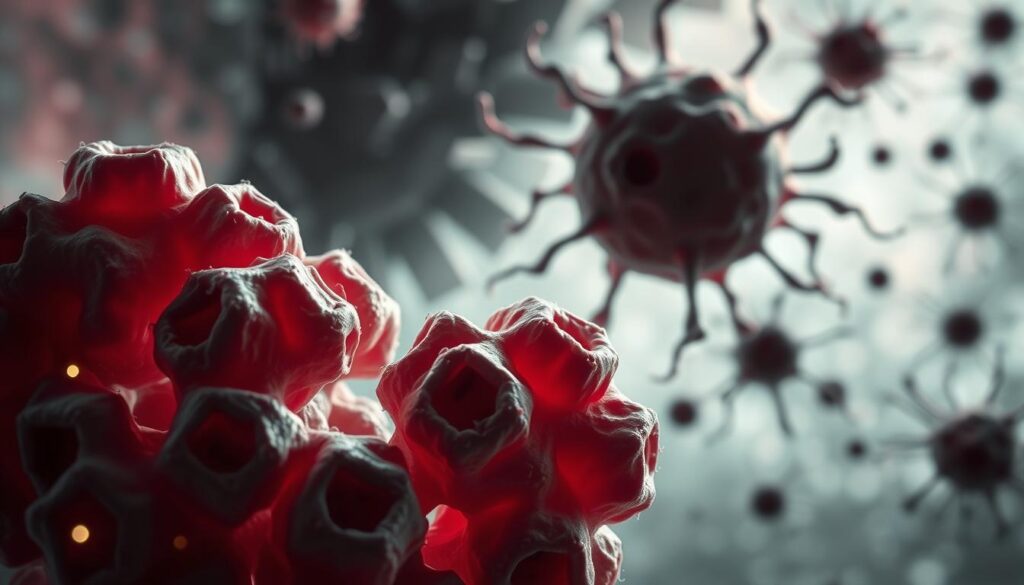Welcome to a journey of cancer awareness. It’s a key step in understanding cancer better. The world of cancer is vast and complex. But, learning about it is not just about gathering facts. It’s about fighting this tough enemy.
We’ll get help from top groups like the American Cancer Society and the World Health Organization. Together, we’ll explore the world of cancer. We’ll see how awareness helps in preventing, diagnosing, and treating cancer.
Key Takeaways
- Gaining a deep understanding of cancer is key to managing and preventing it.
- Cancer awareness leads to better prevention, timely diagnosis, and treatment.
- There are many types of cancer, each needing its own knowledge and approach.
- Trusted sources like the American Cancer Society offer valuable information and guidance.
- Knowing about genetics and lifestyle can help assess personal risk.
- Early screening and awareness campaigns are vital in the fight against cancer.
Understanding Cancer Fundamentals

Understanding cancer goes beyond its medical definition. It involves how cancer cells grow, the role of genetics, and common myths. Knowing these helps us understand how cancers develop and impact our health.
What is Cancer?
Cancer starts when cells in the body grow out of control. Unlike normal cells, these cells keep growing and dividing. This can cause tumors, invade nearby tissues, and spread to other organs.
This process, called metastasis, makes treatment harder because cancer cells evade the immune system.
The Role of Genetics in Cancer
Lifestyle and environment play big roles in cancer risk. But genetics are also key. Some DNA mutations from our parents can increase cancer risk. Knowing these genetic factors helps in creating better treatments.
| Gene Mutation | Associated Cancer Type |
|---|---|
| BRCA1, BRCA2 | Breast and Ovarian Cancer |
| p53 | Liver, Breast, and Colorectal Cancer |
| APC | Colorectal Cancer |
Common Misconceptions About Cancer
It’s important to talk about cancer myths to educate people and reduce fear. Many think cancer is always inherited, but most cases come from mutations during our lifetime. Another myth is that all tumors are painful and easy to find, but many cancers start without symptoms.
Major Cancer Types and Their Impact
We look into how different cancers affect people. We focus on the big cancer types that hit women and men hard. We also talk about the special challenges in treating cancer in kids.
Cancers Affecting Women
When we talk about women’s health, breast and ovarian cancers are big concerns. The Susan G. Komen Foundation says breast cancer makes up 30% of new cancer cases in women. Genes and lifestyle play big roles in these cancers, making it key to catch them early.
Cancers Affecting Men
In men’s health, prostate and testicular cancers are common. The Prostate Cancer Foundation says prostate cancer is the top cancer in men, with 1 in 9 getting it. Catching these cancers early is key to treating them well.
Childhood Cancers: A Special Focus
In pediatric oncology, we face special challenges. St. Jude Children’s Research Hospital says kids’ cancers act differently than adults’. They need special treatments. The emotional and social effects on kids and their families need special care too.
Understanding how cancer affects different groups is vital. It shows the need for focused research and care plans. This helps improve survival rates and quality of life for everyone.
Spotlight on Organ-Specific Cancers
We’re focusing on cancers that often hit specific organs. This includes breast cancer awareness, prostate health, and lung cancer risks. Our goal is to boost detection and improve patient care through education and prevention.
Breast Cancer: Signs and Symptoms
Breast cancer is a big concern for women worldwide. Look out for changes in breast shape, lumps, and skin texture. Early detection through mammograms is key to successful treatment.
Prostate Cancer: Early Detection and Treatment
Men need to watch their prostate health, more so as they get older. Early detection with PSA tests can lead to better treatment options. Treatments range from surgery and radiation to new methods like precision medicine, based on the cancer’s stage and type.
Lung Cancer: Causes and Prevention
Lung cancer risks go up with smoking and exposure to toxins. But, it can also hit non-smokers. Quitting smoking and avoiding toxins are key. Regular health checks can catch problems early.
Knowing about these cancers helps people stay on top of their health. This leads to early action and better treatment results.
Risk Factors and Prevention Strategies
Knowing the many risk factors for cancer is key to preventing it. Making lifestyle changes can greatly lower your risk. Early detection and genetic screening are also vital in catching cancer early.
Lifestyle Changes to Prevent Cancer
Changing your daily habits is essential in fighting cancer. Eating a diet full of fruits and veggies, staying active, and not smoking are important. These actions can greatly reduce your risk of many cancers.
The Importance of Early Screening
Regular screenings are critical for catching cancer early. Tests like mammograms and colonoscopies are recommended. They help those at high risk or with a family history of cancer.
Genetic Testing and Risk Assessment
Genetic screening has become more common and effective. It helps find out if you’re at higher risk for certain cancers. This knowledge lets high-risk individuals take extra steps to prevent and monitor their health.
The American Cancer Society and Centers for Disease Control and Prevention say these steps have helped lower cancer rates. This is a big win for public health.
Here’s a table showing the main prevention strategies and their impact on cancer risk:
| Prevention Strategy | Related Cancer Type | Impact Level |
|---|---|---|
| Dietary Changes | Colorectal, Breast | High |
| Regular Exercise | Prostate, Lung | Medium |
| Smoking Cessation | Lung, Oral | Very High |
| Genetic Screening | Ovarian, Breast | High (for individuals at high genetic risk) |
| Regular Screening Tests | Various | High |
Advancements in Cancer Treatment
The world of cancer treatment is changing fast. We’re moving from old treatments to new, precise ones. Big steps in chemotherapy innovations, cancer immunotherapy, and personalized cancer therapy are making treatments better. This means better results for patients and more focused treatments.
Breakthroughs in Chemotherapy
New chemotherapy innovations are making treatments work better and with fewer side effects. Drugs now target cancer cells more, leaving healthy cells alone. This makes patients feel better and live better lives.
New ways to deliver drugs, like nanoparticles, get the medicine right to the tumor. This makes treatments more effective and safer for the whole body.
Immunotherapy: Harnessing the Body’s Defense
Cancer immunotherapy is a big hope for fighting cancer. It uses the body’s immune system to attack cancer. Treatments like checkpoint inhibitors and CAR-T cell therapies are showing great results.
Immunotherapy is not just treating cancer well. It’s also helping prevent it from coming back. This is a big change from old treatments.
Precision Medicine: Tailored Treatments
Personalized cancer therapy matches treatments to each person’s genes. This makes treatments very specific and effective. It’s all about using genetic information to find the best treatment for each patient.
| Treatment Type | Key Advantage | Typical Use Case |
|---|---|---|
| Chemotherapy Innovations | Higher precision, fewer side effects | Widespread cancers, including breast and lung cancer |
| Cancer Immunotherapy | Long-lasting immunity against cancer | Hard-to-treat cancers, such as melanoma |
| Personalized Cancer Therapy | Treatment tailored to genetic profile | Cases with known genetic mutations |
Using these new methods makes treatments more accurate and effective. It also helps patients live longer and better lives. This shows how powerful modern medicine is in the fight against cancer.
Cancer types
Exploring cancer classifications gives us a deeper look at its complexity. Cancer is a wide range of diseases that can appear anywhere in the body. This makes treatment and research very challenging. We will look at both common and uncommon cancers, and the breakthroughs that could change treatment and help patients.
Overview of Common and Rare Types
It’s important to know about both common and rare cancers. For example, breast and lung cancers are very common. But there are also rare cancers like sarcomas, which make up less than 1% of cases. You can find out more about different cancers here.
Less common cancers like myeloma, brain, and spinal cord cancers are also important. Understanding these uncommon cancers is key to finding better treatments. This can greatly improve care and survival rates for patients.
Emerging Research on Understudied Cancers
Research is vital for understanding less known cancers. It helps find new treatments and better ways to diagnose these diseases. This is important for early detection and managing these cancers effectively.
Today, research is moving beyond common cancers to tackle rare ones. This shift aims to help everyone affected by cancer, not just the most common types. It shows a move towards a more inclusive and advanced global cancer strategy.
Living with Cancer: A Survivor’s Guide
Starting your journey with cancer means facing many challenges. You’ll deal with treatments, emotional ups and downs, and changes in your lifestyle. This part of the article is here to guide you through daily life, find support, and handle the uncertainty of remission and relapse. Building a strong support network, taking care of your mental health, and understanding treatment plans can help you find strength and comfort.
Navigating Daily Life and Treatment
Living with cancer while getting treatment is a delicate balance. You’ll need to manage your schedule, deal with side effects, and try to keep things normal. Setting achievable goals, using treatment calendars, and getting help from others are key. Practical help, like rides to appointments and meals, is also essential for daily survival.
Coping with cancer is not just physical; it’s also mental. Having a strong support system, like family and friends, is vital for your mental health. Groups like the American Psychosocial Oncology Society offer counseling and therapy, which can greatly improve your well-being.
The Journey of Remission and Relapse
Remission brings relief, but the risk of relapse is always there. Knowing the signs of relapse and keeping up with doctor visits is important. Taking care of your health, watching for body changes, and addressing concerns quickly is also key.
| Phase | Challenges | Strategies |
|---|---|---|
| Treatment | Managing side effects, keeping appointments | Scheduled routines, support groups |
| Remission | Anxiety over relapse, regular health monitoring | Regular medical follow-ups, mental health support |
| Overall Survivorship | Physical and emotional fatigue | Community support, engaging in wellness activities |
The path of living with cancer is complex and filled with challenges. It needs support, resilience, and smart choices. By using structured systems, getting mental health support, and actively managing treatment and remission, you can navigate cancer survivorship with hope and strength.
Conclusion
Starting a cancer journey is a big challenge. It involves many steps from finding out you have cancer to getting treatment. We’ve looked at how to understand cancer, its types, and how it affects people.
We talked about how genetics play a part in cancer. We also talked about how lifestyle changes can help prevent it. And we saw how new treatments are changing how we care for patients.
Organizations like the World Health Organization and CancerCare offer important help. They give medical advice and support to those going through tough times. They help with early detection and care that fits each person’s needs.
In the end, fighting cancer needs many steps. We need to prevent it, use new treatments, and support mental health. But, we’re making progress thanks to education and support.
Medical advances give us hope for a future without cancer. We want to inform and inspire those affected by cancer. We believe in their strength and hope for a better future.




